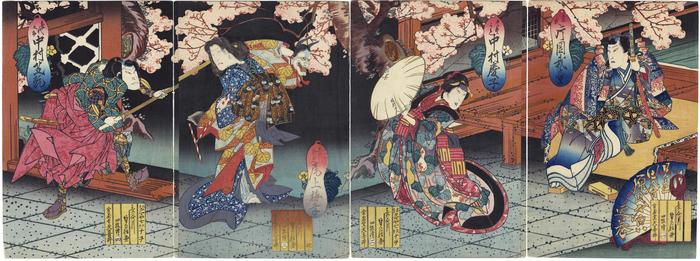Hasegawa Sadanobu I (初代長谷川貞信) (artist 1809 – 1879)
From right to left: Kataoka Gadō II (片岡我童) as Hikaru Uji (光氏); Nakamura Tomijūrō II (中村富十郎) as Tasogare (たそかれ); Onoe Kikugorō III (尾上菊五郎) as Shinonome (しののめ); Nakamura Shikan III (中村芝翫) as Kiyonosuke (喜代之助) - a Rustic Genji theme
1841
39.5 in x 14.75 in (Overall dimensions) Japanese woodblock print
Signature: Hasegawa Sadanobu ga (長谷川貞信画)
Publisher: Kinkadō Tenki (金花堂天喜梓)
Carver seals: hori Kuma Yashichi (ホリクマヤ七);
Printers: suri Nao (スリナヲ) and suri Masa (スリ政)
Lyon Collection - Shinonome with a demon mask in a triptych by Kuniyoshi
Tokyo Metropolitan Library - another copy of the far left panel
Tokyo Metropolitan Library - another copy of the next to far left panel
Tokyo Metropolitan Library - another copy of the far right panel
Tokyo Metropolitan Library - another copy of the next to far right panel This is an imaginary staging, a mitate of the Inaka Genji Yūgao no maki (Rustic Genji — Yugaō chapter: 田舎源氏夕顔廼巻).
****
"The literary classic Genji monogatari (Tale of Genji: 源氏物語) was written by the Kyoto-born Murasaki Shikibu (紫式部) in the early eleventh century. Yūgao ("Evening Faces") refers to the fourth chapter, whose associated crest (Genji-mon) appears on Tasogare's red obi. In the original tale, prince Genji is enamoured of a frail beauty named Yūgao, so he arranges a secret meeting and decides to take her away the following day. That night, however, he awakes to find an apparition near Yūgao's pillow. When he tries to wake her, he discovers she has died. Genji then insists on finding her daughter, intending to raise her as his own.
The "Rustic Genji" theme that made its way into various ukiyo-e prints and paintings was inspired by Nise Murasaki inaka Genji (The Rustic Genji, false Murasaki: 偐紫田舎源氏), a Japanese literary parody. The series, written by Ryūtei Tanehiko (柳亭種彦 1783-1842) with illustrations by Utagawa Kunisada, was published in a woodblock edition between 1829 and 1842. It is one of many gōkan (lit., "combined volumes": 合巻), a popular literary form in multi-volume sets that merged images with text.
Design
Sadanobu's mitate-e (generally a witty comparison, but here meaning an imaginary casting) probably played off the Yūgao theme in clever ways, but we do not have a script to know for certain just what the present scene depicts. The approximate date of 3/1841 comes from Prof. Matsudaira Susumu's 1997 monograph on the artist Sadanobu, which did not provide a specific source for the dating.
One mark of a special edition is the inclusion of carver and printer seals, which appear on only a very small percentage of Osaka prints; however, such seals are found in the rectangular cartouches at the bottom of each print in Sadanobu's tetraptych. The four sheets bear the respective numbers indicating their position in the polyptych, preceded by text reading "four sheets" (四枚続). This rarely available design survives here in an exceptional state of preservation.
Provenance
This impression comes from the much-admired Martin Levitz collection, New York City. Some of the Levitz prints were used to illustrate Schwaab's Osaka Prints (1989)."
Quoted directly from Osakaprints.com.
***
If you click on the image and enlarge it you will notice that the figure of Shinonome - second from the left - is holding a Nō mask of a female demon. This is a reference to the Nō play Lady Aoi where now Shinonome is a substitute for the maddened and vengeful Lady Rokujō.
There is another composition in the Lyon Collection, this one a triptych by Kuniyoshi, in which the character of Shinonome also is holding a female demon mask, like the ones worn in Nō play Nō plays. (See the link above.)
Kinkadō Konishi (金花堂小西) (publisher)
Genji related prints (Genji-e - 源氏絵) (genre)
Kyōto-Osaka prints (kamigata-e - 上方絵) (genre)
Kataoka Gadō II (二代目片岡我童: from 1837 to 12/1856) (actor)
Nakamura Tomijūrō II (二代目中村富十郎: 1/1833 to 2/1855) (actor)
Onoe Kikugorō III (三代目尾上菊五郎: 11/1815-3/1848) (actor)
mitate-e (見立て絵) (genre)
Ryūtei Tanehiko (柳亭種彦) (author)
